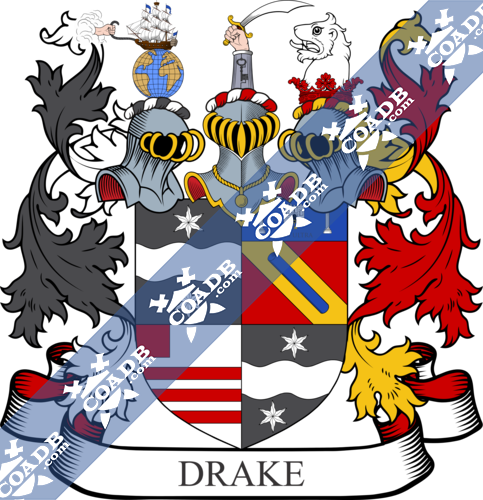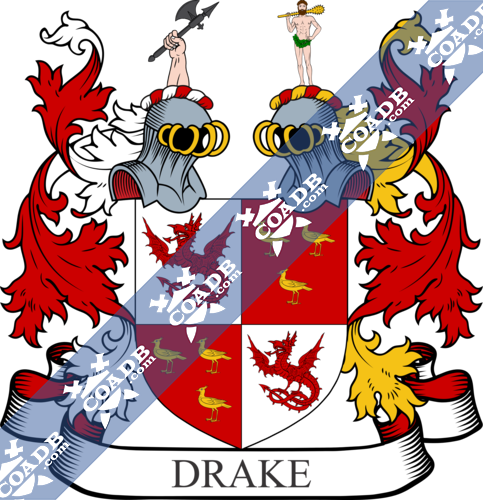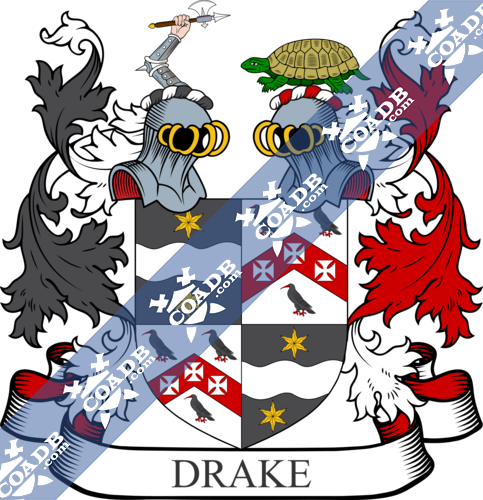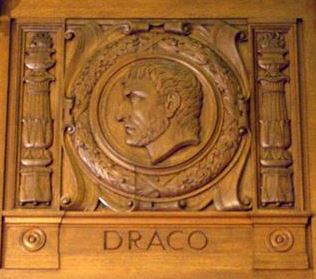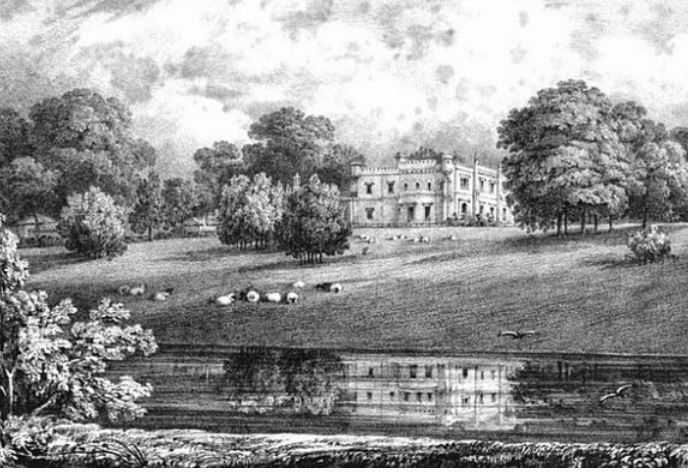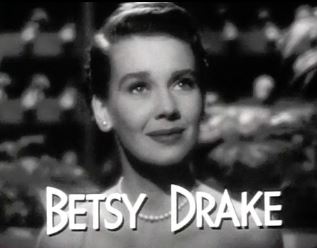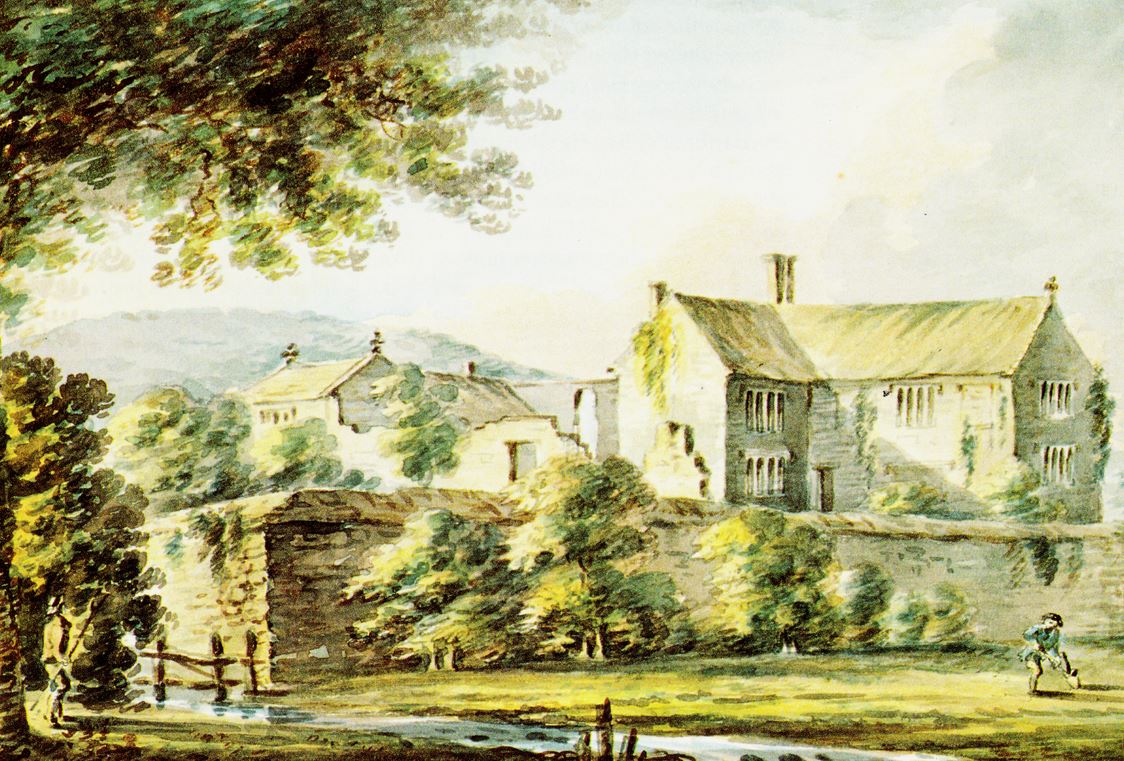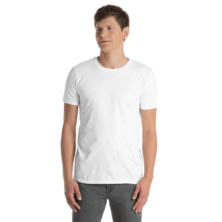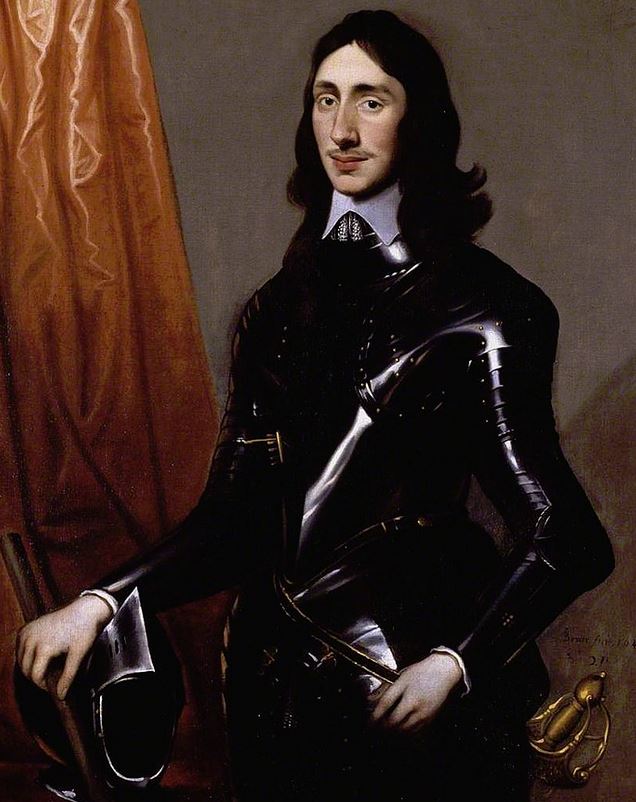Drake Family Crest, Coat of Arms and Name History

Drake Coat of Arms Gallery
Don’t know which Coat of Arms is yours?
We can do a genealogical research. Find out the exact history of your family!
Learn MoreDrake Surname Name Meaning, Origin, History, & Etymology
There are seven origin theories to the popular Anglo-Saxon surname Drake. First, some believe it derived from the Old English personal (first) name Draca, meaning snake or dragon. Second, it may derive from the Old Norse cognate Draki, which was a masculine given name. In these scenarios, the word ultimately derives from the Larin word draco, meaning snake or monster. Third, some believe it developed as a English or Dutch nickname meaning “the drake”, i.e. a duck, goose, or wildgoose, perhaps referring to a person whose resembled a drake, for a person to lived at a house distinguished by the sign (arms) of a drake, for a person who was fierce in battle, or for a person who walked like a duck. Fourth, it may derive from a nickname from the Low German word drake, meaning dragon, similar to the German surname Drach. Fifth, as espoused by Eldson Coles Smith in his 1956 book Dictionary of American family names, it may have developed as a name for a person who played a dragon in “the mysteries and miracle plays”. Sixth, Henry Barber, in his 1903 book British Family Names, offers another theory stating the name may be Scandinavian or from northwestern Europe: Danish originally (from Dræger, Dracke), Swedish (from Draghi or Drake), Dutch (from Drager), and Flemish (from Draecke). Seventh, it may have developed as a metonymic occupational last name for a standard bearer, called a Draker.
The book Patronymica Britannica, authored by Mark Antony Lower in the middle of the nineteenth century, states the following in regard to this name: “Several families of Drake bear as arms the wyvern, or two-legged dragon; and it is worthy of remark that in giving to various pieces of cannon the names of monsters and animals of prey, that of ‘ drake’ was assigned to a peculiar species of gun, as those of caliver, basilisk, culverin, fawconet, saker-all appellations of serpents and rapacious birds-were to others. The compounds, “fire-drake,” and “hell-drake,” become intelligible when the latter syllable is understood to mean, not the harmless and familiar denizen of the pool, but the ‘ fell dragoun ‘ of medieval romance. Sir Thomas Smith, in his treatise “De Republica Anglicana,” speaking of his contemporary, the celebrated Elizabethan admiral, Sir Francis Drake, (contrary to the generally received notion that he was bom in Devonshire,) asserts that he was the son of a fisherman in the Isle of Wight, and that the name of Drake was not his family appellation but an assumption: “Draconis nomen ipse sibi sumpsit, quod est serpentum quoddam genus.” He adds that the Dunkirkers fitted out a fine ship called the Dog, for the purpose of hunting and perhaps catching this sea-serpent: “Dunkercani insignem navem instruxerunt, Doggam (id est Canem) a se appellatam, innuentes ea se Draconem hunc venaturos et forte capturos.” Le Drac is an ancient form of the name.”
An English branch of the family was established in county Wexford, Ireland when the progenitor came there as a Cromwellian official. They were known as the Drakes of Stokestown. However, thy family was already present in Dublin in the 1200s AD. This family was known as the Drakes of Drakerath. Edward MacLysaght’s book, published in 1964, Supplement to Irish Families, states the following in regard to this name: “Drakerath is near Kells. There is a Drakestown in Co. Meath in the barony of Morgallion, also named from the Drake family-in this case a parish as well as a townland. Another Drakestown, yet again the home of Drake family in mediaeval times, is in Co. Louth (bar. Ardee). Their prominence up to the time they lost their estates under the Cromwellian regime is indicated by the frequency with which their name occurs in all kinds of records relating to Leinster (and to a small extent also to Co. Cork): there are for example 65 references to Drak and Drake in the Patent Rolls from 1318, when the first in that source occurs, down to 1509” and “The Norfolk Drakes are now well established in Attleborough and Norwich. The name was connected with the municipality of Norwich as far back as the 15th century, and a gentle family of Drake lived at Hardley in the time of Elizabeth (Bl.). The name now occurs also in Dorset, Devon, and in the West Biding. In the 13th century it was established in Lincolnshire, Hunts, and Cambridgeshire”.
The family may have been Norman in origin. The surnames Drake and Draco derived from Fitz-Draco, which in turn derived from Drogo, which derived from Fitz-Drago. A one Drogo de Montaute in 1086 AD who held Chenolle, Somerset, Shepton, and numerous lordships in Devon from the Bishop of Coutances. Prior to 1146, a one Robert Draco (or Fitz-Droco or Drogo) witnessed the founding charter of Exeter Priory. The branch of the Drake family tree from Devon, England had a coat of arms that depicted a dragon (Drogo), which strongly suggests the family descended from Draco or Fitz-Draco.
In England, the family held seat (land, positions, titles) in Hampshire during the Middle Ages. The name was also present in the Isle of Wight from early times. The family was also present in the parish of Musbury, Devon, England in the Middle Ages. In his 1848 book A Topographical Dictionary of England, Samuel Lewis states the following in regard to this location and surname: “This place was the residence of the Drake family, from the time of Henry VII, for several generations. The church is a very ancient structure, with a south aisle added toward the close of the fifteenth century, by the Drake family, to whom it contains some monuments. Ash House, now occupied as a farmhouse, derives interest from having been the birthplace, in 1650, of the renowned Duke of Marlborough, whose mothers was then on a visit to her father, Sir John Drake”. Per the same book, another branch of the Drake family tree was found in Yarcombe, Devon, England that consisted of 5,000 acres, owned by Sir H.F.T.S Drake, whose ancestor, was granted the manor by Queen Elizabeth.
For more information, see a book called “The Drake Family in England and America 1360 to 1895” by Louis Stoughton Drake. Here is a brief excerpt “Soon after the conquest of Wessex by the Saxons, a family or clan called Draco or Drago appear to have taken possession of an old Roman and British encampment in what is now Musbury, Devon County, England, which subsequently became known as Mount Drake. From this family it is probable that all of the name in England and Ireland are descended, as, although the crests of the various families of Drakes in later days varied, their arms were the same, thus providing the common origin of the family. That the family is of great antiquity is shown from the fact that before the Norman conquest, 1066, A.D., they were well established in Devon County. In Domes Day Book six places are mentioned as possessed by persons of the name. We are told that “Honitou, one of them, was well known to the Romans, and was held by Drago, the Saxon, before the conquest.” The name Drago or Draco, the Latin for Drake, was in use among the Romans, and signifies “one who draws or leads,” a “leader.” Their standard bearers were called Draconarii. The Romans obtained the name from the Greeks, among whom it is found as early as 600, B.C., when Draco, the celebrated Athenian legislator, drew up the code of laws for the government of the people which bore his name”.
Spelling Variations
 Some spelling variants or names with similar etymologies include Drakes, Dracke, Drakey, Drax, Dracas, Dracass, and others.
Some spelling variants or names with similar etymologies include Drakes, Dracke, Drakey, Drax, Dracas, Dracass, and others.
Popularity & Geographic Distribution
The last name Drake ranks 506th in popularity in the United Status as of the 2000 Census. The name ranks particularly high in the following nine states: Idaho, Kansas, Nebraska, Iowa, Georgia, Ohio, Michigan, Indiana, and Wyoming. The surname Drake frequency/commonness ranks as follows in the British Isles: England (617th), Scotland (1,558th), Wales (719th), Ireland (2,580th) and Northern Ireland (1,508th). In England, it ranks highest in counties Rutland and Norfolk. In Scotland, the surname ranks highest in West Lothian. In Wales, it ranks highest in Cardiganshire. In Ireland, it ranks highest in county Longford In Northern Ireland, it ranks highest in county Down. The name is also present throughout the remainder English speaking world: Canada (1,103rd), New Zealand (546th), Australia (934th), and South Africa (1,822nd). Henry Brougham Guppy’s 1890 book Homes of Family Names in Great Britain states the following in regard to this last name: “The name of Drake has long been associated with this county. Sir Francis Drake, the Elizabethan hero, was born at Crowndale, Tavistock, in 1541. He was the first of the line of baronets of Buckland – Monachorum, but the baronetcy became extinct about 1736). Westcote refers to the ancient gentle family of Drake of Ash – in – Musbury, in the 16th and 17th centuries. In the 17th century a gentle family of Drake resided at Spratsliayes, Exmouth. Henry Drake was mayor of Barnstaple in 1679. Drake is also found numerously represented in the neighbouring county of Dorset. Further reference to this name will be found under “Norfolk” and “Drake is a characteristic Dorset name. A gentle family of Drake owned Childhay manor, Broad Windsor, in the reign of Charles I.; and John Drake was a West Chelborough gentleman in the reign of Charles II”.
Early Bearers of the Surname
One of the earliest documented bearers of this surname was Leuing Drache, who was listed in the Domesday Book of Hampshire in 1086 AD. Richard le Drake, county Lancashire, 1332 AD in the Lay Subsidy. Adam de Drake was documented in the Calendarium Inquisitionum Post Mortem. Martin le Drake was documented in the Rotuli Litterarum Clausarum in Turri Londinensi. Stephen Drake was documented in county Somerset in Kirby’s Quest in 1328 AD. The Hundred Rolls of 1273 AD, a census of Wales and England, known in Latin as Rotuli Hundredorum lists one bearer of this surname: Seman Drake in county Cambridgeshire, England. The Poll Tax of 1379 AD lists one Ricardus Drake “er Magota uxor ejus” and Johannes Drac. An early marriage involving this surname was Sarah Drake to Thomas Martin at St. Dionis Backchurch in 1645.
Drake Family Tree & Drake Genealogy
The following is a discussion of seven different noble, royal, landed, or aristocratic families bearing this last name.
Drake of Oatlands
The lineage or ancestry of this branch of the Drake family tree traces back to an old family that lived in county Devon, England for several hundred years. In 1303 AD, Roger le Drak owned Hurnford-cum-terra de la Wood of Derington. John Drake was an Esquire of Exmouth, Devon who lived in the 1400s AD and married Christiana, daughter and co-heir of John Billet of Ashe. He was the ancestor or progenitor of the Drakes of Ashe and Tyrwhitt-Drake of Shardeloes, Buckinghamshire, both of which are discussed in the below sections. Further down the Drake family tree came one Henry Drake, an Esquire, who was the Mayor of Barnstaple where he settled. His second wife was named Anne Yeo, and she had a son and heir with her named John. John was an Esquire of Barnstable who was born in 1682. In 1706, he married Christian, daughter and co-heiress of Robert Hacche of Satterleigh Park, and had two sons with her as follows: Henry (married Mary Tucker and had a son named John) and John (of Barnstaple, married Anne, daughter of Lewis Gregory). John had two issue: Joan (married George Edwards) and Henry. Henry Drake was an Esquire of Barnstaple who was born in 1745. In 1771, he married Ann, daughter of Richard Hammett of Kennerlaand, and had issue as follows: 1) Zachary Hammet Drake (Esquire of Springfield, Justice of the Peace and Deputy Lieutenant for Devon and Cronwall, married Frances Cutliffe of Marwood Hill, had issue named Reverend Zachary Hammett Drake, Charkes Cutliffe Drake, and Francis Mervin), 2) John (died 1799), 3) Henry (born 1781, had a daughter named Katherine who married Major Frank Sisson Brooke), 4) Richard (born 1786), 5) William Drake (born 1787, married Frances, daughter of Robert Lincoln, had issue named Sir William Richard Drake who is discussed below, Henry, and Frances Ann), 6) Anny (died 1839), and 7) Elizabeth (died 1862). Sir William Richard Drake of Oatlands Lodge, county Surrey. England (modern day United Kingdom, once called Great Britain) was born in 1817 and knighted in October of 1869. He was a Knight Commander of the Italian Orders of SS Maurizia and Lazzaro and of the Corona d’Italia, a Knight of the Austrian Order of the Iron Crown, and Member of the Turkish Order of the Medjidie. In 1840, he married Kathatine Stewart Forbes, daughter of Richard Thomas Goowdin. The Drake Coat of Arms (mistakenly called the Drake Family Crest or Drake Family Shield by those unfamiliar with heraldry and genealogy) is blazoned in the medieval/Middle Age European art of heraldry as follows: Quarterly, 1st and 4th argent, a wyvern, wings displayed and tail nowed gules; 2nd and 3rd, gules, two demi-lions passant guardant couped or. Crests: 1st, A dexter arm erect couped at the elbow proper holding a battle axe sable headed argent; 2nd, An eagle displayed gules. Moto: Tyme Tryeth Trvthe.
Drake of Stokestown
The Drake genealogy of this Irish line begins with Roger Drake, an Esquire of Stokestown, county Wexford, who went to Ireland along with William Glascott, where he received a grant of Stocktown and other forfeited property in county Wexford. He married Hannah, daughter and co-heir of Major Samuel Sheppard, and had issue with her as follows: John (his heir), Roger, Mary, Charity, Margaret, and Patiens. He died in 1678 and was succeeded by his eldest son John. This John Drake married Mercy, daughter or niece of William Bayne of Clocane in Kilkenny, Ireland, and was the father of six children with her as follows: 1) John (died 1729), 2) Darius (his heir), 3) Samuel (died 1729), 4) George (of Coolback, married Elizabeth Allen of Allen’s Grove, and had a son with her named John, John married Sarah Hanfield and had issue with her named George, John Hanfield, and Sarah), 5) Juliana (born 1721), and 6) Ann. He died in 1740 and was succeeded by his eldest surviving son Darius. Darius was an Esquire of Stokestown born in 1711. He first married Jane, daughter of Alexander Boyd of Crook, and had the following children with her: John (his heir), Anne (born 1750), and Urith (married Robert Paul of Johnshill, county Waterford, in 1755). H died in 1777 and was succeeded by his son John. John Drake was an Esquire of Stokestown and a High Sheriff of Wexford, Ireland, who was born in 1743. He died without posterity in 1809, at which time his property devolved to his sister, Urith Paul, who gave it to her cousin, the heir male of the family. This cousin was George Drake who was an Esquire of Stokestown who was born in 1776. He died in 1852 without posterity, at which point the land/estates devolved to his sister, Mrs. Deane. When Mrs. Deane died, the estates went to her son, John Deane Drake. This John Deane Drake was an Esquire of Stokestown and Justice of the Peace for Wexford who was born in 1813. He assumed the additional surname and arms of Drake upon the death of his uncle. In 1843, he married Emily Letitia, daughter of Thomas Henry Watson, Esquire of Lumclone, county Carlow, with whom he had the following issue: Joseph Edward (see below), Henry Thomas (Lieutenant of the 56th Regiment), John Hanfield, Cosby Francis, Georginia, and Sarah Cecilia (married William Price Llewellyn Lewees in 1872). He died in 1855 and was succeeded by his son Joseph. This Joseph Edward Deane was an Esquire of Stokestown, county Wexford, Ireland who was born in 1845. The Drake Coat of Arms has the following heraldic blazon: Arms, Quarterly, 1st and 4th, sable, a fess wavy argent between two pole stars or for Drake; 2nd and 3rd, argent, on a chevron gules between three Cornish choughs sable three crosses formee of the field, for Deane. Crests: 1st: Drake, a cubit arms in armour the hand grasping a battle all proper, motto over, Auxilio divino; 2nd Deane: A tortoise displayed proper, motto over, Ferendo non feriendo. Motto: Sic parvis magnau. The family was seated (held land, estates, titles, positions) at Stokestown, New Ross, county Wexford, Ireland.
Drake of Ashe
The lineage or ancestry of this branch of the Drake family tree traces back to county Devon in England. In 1303 AD, Roger le Drak owned Hurnford-cum-terra de la Wood of Derington. John Drake was an Esquire of Exmouth, Devon who lived in the 1400s AD and married Christiana, daughter and co-heir of John Billet of Ashe. He had a son with her also named John. This son, John Drake, Esquire of Otterton, married Christiana, daughter and heiress of John Antage, and had a son with her, also named John. This son John was also of Otterton and he married a daughter of John Cruwys, and had a son also named John. This son, John Drake IV, was of Otterton and married Agneta, daughter of John Kelowa, and had children with her as follows: John (his heir), Richard, Robert, and Thomas (of Hartford, Devon, married Ellen Hilton of South Awtry, had five children). John Drake V was of Exmouth and Ashe who married Margaret, daughter and heiress of John Cole of Rill in Withcombe Raleigh. He had three sons. His eldest son, John Drake VI, was an Esquire of Ashe, who married Amye Grenville, and had three sons with her as follows: Bernard (his heir), Richard (held a position to Queen Elizabeth, married Ursula Stafford, progenitor of the Drakes of Shardeloes), and Robert (Wiscomb Park, married Elizabeth, daughter of Humphrey Prideaux of Theoborough, and had seven sons and three daughters with her named William, Bernard, John, Robert, Henry, Nicholas, Humphrey, Gertude, Amye, and Ursula. He died in 1558 and was succeeded by his son Bernard. Sir Bernard Drake, Knight, was of Ashe and Mount Drake, a mansion he constructed. He was knighted by Queen Elizabeth at Greenwich in January of 1585. He died the same year. He had married Gertude, daughter of Bartholomew Fortescue) and had two surviving issue: John (his heir) and Margaret (married John Sherman of Ottery St. Mary, had a daughter named Alice who married Richard Perceval). His son John Drake of Ashe and Mount Drake married Dorothy, daughter of William Button of Alton, fathered three children with her as follows: 1) John (discussed below), 2) Mary (married Sir Henry Rowswell), and 3) William (of Yardbury, married Margaret, daughter of William Wesover, had issue with her). He died in 1628 and was succeeded by his eldest son. This son, Sir John Drake, Knight, was of Ashe. He married Helena, daughter of John, Baron Boteler, of Bramfield, county Hertsford, England and Elizabeth Villiers. The following issue resulted from this marriage: Sir John Drake of Ashe (created a Baronet, married and had issue), George, Thomas, Henry, Dorothy (married William Yardley), Mary, Eleanor (married John Briscoe of Cumberland), Elizabeth (married to Sir Winston Churchill, had son named John Churchill, the Duke of Marlborough). He was succeeded by his son Henry Drake. He died in 1688 and was succeeded by John Drake, Esquire of Barnstaple, who was born in 1682. In 1706, he married Christian, daughter and co-heiress of Robert Hacche of Satterleigh Park, with whom he had two sons: John and Henry (married Mary Tucker). The son John was of Barnstaple who was born in 1710. In 1733, he married Anne, daughter of Reverend Mr. Gregory, and died in 1770, have issue named Joan (married George Edwards of the Royal Navy) and Henry. The successor was Henry Drake, an Esquire of Barnstaple, who was born in 1745. In 1711, he married Ann, daughter of Richard Hammett of Kennerland, in the parish of Clovelly, with whom he had seven issue as follows: 1) Zachary Hammett Drake (Esquire of Springfield, Justice of the Peace and Deputy Lieutenant for Devon and Cornwall, married Frances Cutcliffee, had issue named Zachary Hammett, Charles Cutcliffe, and Frances Mervin), 2) John, 3) Henry (born 1781, married and had three daughters), 4) Richard (born 1786), 5) William (married Frances Lincoln in 1787, had children named William Richard Drake, Henry, and Frances Ann), 6) Ann, and 7) Elizabeth. The arms of this branch of the Drake family tree (mistakenly called the Drake Family Crest) is blazoned in heraldry as follows: Argent, a wyvern, wings displayed and tailed nowed gules, Crests: 1st, a dexter arm, erect, couped at the elbow, proper, holding a battle ax, sable, headed, argent; 2nd, an eagle, displayed gules. Motto: Aquila non captat muscas.
Tyrwhitt Drake of Shardeloes 
The lineage of this branch of the family begins with Richard Drake, Esquire, third son of John Drake of Ashe and Amye Grenville, who married Ursula, daughter of Sir William Stafford. He died in 1603 and was succeeded by his son Francis. Francis Drake was an Esquire of Easher, a gentlemen of the privy chamber in ordinary. He married Joan, daughter of William Tothill of Shardeloes, and was the father of the following children: William (his heir), John, Francis (of Walton-on-Thames), and Joan. He died in 1633 and was succeeded by his eldest son William. This Sir William Drake of Shardeloes was born in 1606. He was a chirographer to the Court of Common Pleas, and was created a Baronet in 1641. He died in 1669, whereupon the title became extinct, but the estates were passed on to his nephew. This nephew, Sir William Drake, Knight, was of Shardeloes and was a Member of Parliament for the borough of Agmondesham, son of Francis of Walton-on-Thames and Dorothy Spring. He married Elizabeth, daughter of co-heiress William Montague, and two issue with her: Mary (married Sir John Tyrwhitt) and a son named Montague. The son, Montague Drake, was an Esquire of Shardeloes and a Member of Parliament for Agmondesham. He married Jane, daughter and heiress of Sir John Garrard, Baronet of Lamer, and he had two issue with her: Mary (married Sir Edward Everard, Baronet) and Montague. This son, Montague Garrard Drake, was an Esquire of Shardeloes and Member of Parliament. He married Isabella, daughter and heiress of Thomas Marshall. He died in 1728 and was succeeded by his son, William. This William was an Esquire and LL.D. of Shardeloes, and Member of Parliament for Agmondesham starting in 1746. Her married Elizabeth, daughter of John Raworth, with whom he had the following children: William (LL.D and Member of Parliament), Thomas (his heir), John (LL.D, Rector of Agmondesham, married Mary Wickham), Charles (assumed the name of Garrard), Elizabeth (married Reverend Richard Frank), and Isabe. He died in 1796 at the age of 72. He was succeeded by his son Thomas. This Thomas Drake was an Esquire, LL.D, of Shardeloes, who in 1776, assumed the arms and surname of Tyrwhitt, but when he inheritied his father’s estates, resumed, in additional, his paternal name, being now called Thomas Tyrwhitt Drake. He married Anne, daughter and co-heiress of Reverend William Wickham of Garsington in Oxford, England, and fathered seven children with her as follows: 1) Thomas (heir), 2) William (married Emma Halsey and had children), 3) John (Rector of Amersham, married Mary Annesley and later Emily Drake-Garrard, had son named Captain JCT Drake who married Emily Harriet D’Urban), 4) George (Rector of Malpas in county Chester, married Jane Halsey, had issue including Reverend Frederick Edward, Montague William, George Arthur, William Henry, Louisa Jane, Adelaide Emma, Anne, Octavia Sarah, and Susan Frederica), 5) Frederick William, 6) Mary Frances, and 7) Anne (married Hugh R. Hoare of Lillingtsone, married Reverend John Anthony Partridge). He died in 1810 and was succeeded by his son Thomas. Thomas Tyrrwhitt Drake was an Esquire of Shardeloes, Jystice of the Peace, Deputy Lieutenant, High Sheriff, and Member of Parliament who was born in 1783. In 1814, he married Barbara Caroline, daughter of Arthur Annesley, and had issue with her including: Thomas (discussed below), John, Edward, George, Barbara Anne, Frances-Isabella, Mary Elizabeth, Augustus Charlotte, Elizabeth Catherine, Susan Louisa, Charlotte Ursula, and Agnes Agatha. His son Thomas Tyrwhitt Drake was an Esquire of Shardeloes of counting Buckingham, England and of Stainfield Hall, Lincolnshire, and of St. Donat’s Castle in Glamorganshire, Wales, a Justice of the Peace, a Deputy Lieutenant, and a High Sheriff who was born in 1817. In 1843, he married Elizabeth Julia, daughter of John Stratton, and had the following children with her: Thomas William (1849), William Wykeham (1851), Elizabeth Caroline, Susan Emily, Florence Georginia, Julia Diana, and a son whose name is not known who was born in late October 1859. The coat of arms of this family has the following heraldic blazon: Quarterly: 1st and 4th, a wyvern with wings displayed, and tailed nowed, gules, 2nd and 3rd, gules three ??? wings or. Crests: 1st, a naked arm, erect, proper, holding a battle-axe sable, headed, argent; 2nd, a savage proper, wreathed about the waist and temples, vert, holding over the dexter shoulder a club or.
Drake of Roriston 
This family descends from an ancient Irish branch of this family represented by a person known as Drake of Drakerath, a prominent person in that kingdom under the Plantagenets, Tudors, and Stuarts. The mansion of Drakerath was located in the Barony if Kells in Meath, Ireland, where it remained for hundreds of years. It was built by a member of the Drake of Ashe family (discussed in above sections) of Devon who acquired sizeable lands in Ireland and settled there. The estates remained in the possession of his descendants until the rebellion of 1641, whereupon they were forfeited. However, a small piece was restored by the Court of Claims during the early part of the reign of King Charles II. A cadet of this family, Captain Peter Drake, was a hired soldier, who followed the wars through Europe. Several generations later came one Patrick Drake, son of Columbus Drake, was an Esquire of Drakenrath, who was born in 1712. In 1747, he married Frances, daughter of James O’Reilly of Roriston, Meath, Ireland, and had five children with her as follows: Columbus, George (married Emily O’Reilly, had issue), Catherine (married George Dowdall), Elizabeth (married Nicholas Browne), and Anne. He died and was succeeded by his son Columbus Drake, Esquire of Roriston, who was born in 1750. In 1777, he married Anne, daughter of Christopher Barnewall, Esquire of Fyanstown Castle, county Meath, and had the following issue with her: Patrick, Christopher, Cecilia (married James Archibald O’Reilly of Rahattan in Wicklow, Ireland), Frances, and Anne. He died and was succeeded by his son Christopher. Christopher was born in 1790 and he married Mary Anne, daughter of Nicholas Gannon, and had two issue with her: Columbus Patrick (see below) and Anne Maria. He secondly married Mary, daughter of Alexander Somers, and was the father of five children with her: Christopher Somers, Alexander of Joseph (of Rathbale near Athboy), Charles William, Catherine Cecilia, and Mary Elizabeth. He died in 1854 and was succeeded by his son. This son, Columbus Patrick Drake was an Esquire of Roiston, county Meath, Ireland, as well as a Justice of the Peace. In February 1858, he married Marcella Mary, daughter of Andrew Christopher Palles and Elizabeth O’Ferrall. The Drake Coat of Arms of this Irish line are blazoned in the medieval and Middle Age art of heraldry as follows: Argent, a wyvern, wings displayed and tail nowed gules. Crest: A wyvern, as in the arms. They were seated on Roriston, near Trim.
Other Drake Pedigree & Family Trees
Richard Drake was born in Somerset, England around 1615 AD. He married Thomazine and had a son with her named John. They went to colonial America and settled in Virginia. The son John was born in South Petherton, county Somerset, England around 1647, and he went to Virginia with his dad. He had two sons: Thomas and John. His son Thomas Drake was born in Virginia around 1670 AD. He married and had a son also named John. This John was born in Isle of Wight, Virginia around 1702 AD. He married Mary Brown and had a son with her named John Aaron Drake Sr. This John Aaron Sr. was born in Elizabeth, Virginia in 1746. He married Elizabeth Charity Cireves and had a son with her named John. This John (or Jean or Juan) Drake was born in Carolina in 1776. He married Marie Rosalie Abshire in Louisana, New Spain in 1800. They had the following children together: John Drake III, Marie Rachel (Doyle), Seraphia (Gowen) and Solomon. His son Solomon was born in Calcasieu Parish, Louisiana un 810. He married Margaretta McQueen and had a son with her named Soloman as well. This son, Soloman Quinn Drake, was born in Sugartown, Louisiana in 1848. He married Indiana Berry in 1872. They had a daughter together named Martha Emily Drake who was born in Fall Texas in 1884, marrying twice and having issue, passing away in 1966.
The Drake ancestral line traces all the way back to a man called Hucbold “Count of Ostrevant” who lived in the 800s AD in Nord Pas De Calais, France. Here is the Drake pedigree from him:
Raoul (or Ralph or Radulfus) Gouy (born 877 AD in Vexin, Normandy, France)
Raoul de Cambrai aka de Gouy (born circa 898 AD in Vexin, Normandy France)
Walter “Count of Vexin, Valois, Amiens” Gautier (born circa 920 AD in Vexiv, Normandie, France)
Gauthier II “Walter, Le Blanc, Comte de Mantes, d’Amiens et du Vexin” (born circa 952 AD in Vexin, France)
Count Dreux or Drogo “Valois, Comte de Amiens & Vexin” (born circa 996 AD in Mantes ja Jolie, Yveslines, Ile-de-France)
Ranulf or Ralf or Raoul “The Timid) aka Montfort (born in 1026 AD in Herefordshire, England, married Gytha Clopa)
Harold Fitz Ralph Drake (born in 1054 AD in England)
William Fitz Harold Drake (born in 1099 AD in Whaddon, England)
Humphrey Fitz William Drake (born around 1130, Drakenage, Devon, England)
Robert Fitz Humphrey Drake (born in 1185 in Drakeneage, Devon, England)
Ralph Fitz Robert Drake (born in 1210 in Mount Drake, Musbury, Devon, England)
Reginald Fitz Ralph Drake (born in 1235 AD in Mount Drake)
Roger Fitz Reginald Drake (born in 1260 in Mount Drake)
Nicholas Fitz Roger Drake I (born prior to 1285 in Musbury, Devon)
Robert Drake (born around 1321 in Great Waltham, Essex, England)
William Drake (born prior to 1342 in Great Waltham)
Edmund Drake (born around 1403 in Great Waltham)
William Drake (born around 1449 in Great Waltham, England)
Thomas Drake (born in 1465 in Great Waltham, England, children Clemence, John, Thomas, William Sr.)
William Drake Sr (born 1518 in Great Waltham, Essex)
William Drake Jr (born in 1550 in White Notley)
Robert Drake (born around 1581 in England)
Abraham Drake Sr (born in 1620 in Devonshire, England)
Abraham Drake Jr. (born in 1654 Hampton, Rockingham County, New Hampshire, married Sarah Hobbs)
Abraham Drake III (born in Hampton, New Hampshire in 1688)
Colonel Abraham Drake IV (born in Hampton, NH in 1715)
Weare Drake (born in 1737 in North Hampton, Rockingham, New Hampshire, married Anna Taylor)
John Drake (born in 1768 in North Hampton, Rockingham, New Hampshire)
Nancy Drake (born 1800 in Eggingham, Carroll, NW, married Samuel Tuttle, had issue)
Early American and New World Settlers
The book Genealogical Guide to the Early Settlers, mentions five bearers of this last name:
1) Francis Drake of Portsmouth, 1661, a surveyor, may have moved to New Jersey
2) John Drake of Dorchester or Boston, who came in the fleet with Winthrop, may have been made a freeman in 1630, a purchaser of Taunton, was killed in Windsor in 1659, had sons named Jacob, Job, and John.
3) Robert Drake of Exeter, born in Devonshire in 1630, moved to Hampton and was a selectman there. He died in 1668. He had children named Nathaniel, Abraham, and Susanna.
4) Samuel Drake of Fairfield, 1650, was a representative in 1662, and moved to East Chester. He had three sons named John, Samuel, and Joseph, and four daughters, one named Mary. He was married to Ann.
5) Thomas Drake of Weymouth, with wife Jane, had children named John (1659), William (1661), Joseph (1663), Amy (1666), and Millicent. He may have lived in Dorchester in 1640. He may have been married to a woman named Joan who lived in Boston.
Diana Drake, age 19, went to the Barbados aboard the Alexander in May of 1635.
Joseph Drake, age 18, went to St. Christopher’s aboard the William & John in September in 1635.
Isack Drake, age 25 went to St. Christopher’s aboard the Amirite in October in 1635.
Other settlers in colonial America bearing this surname include Elizabeth Drake (Massachusetts 1630), Richard Drake (Virginia 1701), Margaret Drake (Virginia 1724), Samuel Drake (Virginia 1735), and Hannah Drake (Virginia 1751).
In Canada, one of the first settlers bearing this last name was Francis Drake, who came to Nova Scotia in 1749. In Australia, John Drake came to Van Diemen’s Land (present day Tasmania) around 1830. William Drake, age 26, came to South Australia aboard the Harry Lorrequer in 1849. In New Zealand, in 1840, a family bearing this surname, including Thomas John Drake and Ceres Drake, came to the city of Wellington in the Aurora.
Early Americans Bearing the Drake Family Crest
Charles Bolton’s American Armory (1927) contains three entries for this surname:
1) [Argent] a wyvern with wings addorsed [gules] and tail nowed, the wyvern looks like a cockatrice. Crest: a wyvern of the field on a castle of three embattled towers conjoined. Arms of Richard Drake (d. 1808) and Mary Fearon, his wife (d. 1812). Old St. David’s Churchyard, Radnor, Penn. Zieber Heral., p. 42.
2) [Argent] a wyvern, wings displayed and tail nowed gules. Crests: A: an eagle displated gulrd; B: a dexter arm erect proper holding a battle axe sable headed arg. Mottoes: A: Sic parvis magna; B: Time tryeth tryst. Arms and crest: A on bookplate of William Walker Drake With motto: Aquila non capit muscas. Vermont Amer. Heral., pp. 31, 164.
3) Argent a wyvern with wings addorsed and tail nowed gules. Crest: a cubit arm erect proper grasping a battle axe sable. Motto: Aquila non captat muscas. Water color by Mitchell the gem cutter, Tremont St., Boston, 1905? Framed. The crest and motto used on letter paper. Louis S. Drake, Newton, Mass.
Crozier’s General Armory (1904) contains three entries for this last name:
1) Thomas Drake of Weymouth, Massachusetts, 1653, from Devon, England. Arms: Argent, a wyvern displayed and tail knowed gules. Crest: A dexter arm couped at the elbow proper holding a battle axe sable. Motto: Aquila non captat muscas.
2) John Drake of Boston, Massachusetts, 1630, from Devon, England. Arms: Argent, a wyvern displayted and tail knowed gules. Crest: An eagle displayed gules.
3) Louis Stoughton Drake, Esquire of Newton, Massachusetts bore the same arms as Thomas Drake of Weymouth detailed above.
Matthew’s American Armoury and Bluebook (1907) contains one entry for this surname: John Drake of Boston, MA, 1635, the son of William Drake of Wyscomb, Devonshire, England, and grandson of John Drake, Sheriff of Dover, England. Arms: Argent, a wyvern wings displayed and tail nowed gules. Crest: A dexter arm erect couped at the elbow proper holding a battle-axe sable.
Mottoes
I have identified six Drake family mottoes:
1) Aquila non captat muscas (The eagle catcheth not flies)1
2) Virtus vera nobilitas (Virtue is true nobility)
3) Auxilio divino (By divine aid)2
4) Sic parvis magna (Thus great things arise from small)
5) Fortiter et recte (Boldy and rightly)
6) Per ardua (Through difficulties)
1 – Derived from an ancient Greek proverb.
2 – Refers to the crest of the great circumnavigator’s family, which is a ship drawn round the globe with a cable rope, by a hand out of the clouds, all proper
Grantees
We have 12 coats of arms for the Drake surname depicted here. These 12 blazons are from Bernard Burke’s book The General Armory of England, Ireland, and Scotland, which was published in 1848. The bottom of this page contains the blazons, and in many instances contains some historical, geographical, and genealogical about where coat of arms was found and who bore it. People with this last name that bore an Drake Coat of Arms (or mistakenly called the Drake Family Crest) include: Sir Francis Drake, arms, crest, and augmentation, granted 20 June 1581 by Cooke
Notables
There are hundreds of notable people with the Drake surname. This page will mention a handful. Famous people with this last name include: 1) Sir Francis Drake (1540-1596) who was a famous English sea Captain of the Elizabethan era who was born in Tavisstock, Devon, best known for helping defeat the Spanish Armada in 1588 saving all of Britain and for being the second captain to circumnavigate the globe, 2) Abraham Drake (1715-1781) who was an officer in the New Hampshire Militia who served with the Continental Army during the American Revolution and was also a Lieutenant and Captain who served in the French and Indian War, born in Hampton, NH, who later served as a delegate to the state’s Provincial Congress, 3) Betsy Drake (1923-1905) who was an American actress born in Paris, France whose filmography contains 12 movies such as “Every Girl Should Be Married”, and was the third wife of iconic actor Cary Grant, 4) Charles Daniel Drake (1811-1892) who was a US Senator from Missouri from 1867-1870 who was born in Cincinnati, Ohio, 5) Dallas James Drake (1969) who is a former professional hockey player who play in the NHL from 1990-2008 for four different teams including the Detroit Redwings, having been born in Trail, British Columbia, Canada, who played college hockey at Northern Michigan University, 6) Frank Donald Drake (1930) who is an American astrophysicist and astronomer born in Chicago, Illinois who attended Cornell and Harvard University, best known for pioneering the search for extraterrestrial life, founding SETI and developing the Drake Equation, 7) Franklin Jeremiah Drake (1846-1929) who was a Rear Admiral in the US Navy, born in Yates, New York, who fought in the American Civil War and later the Korean Expedition in 1871, 8) Ervin Drake (1919-2015) who was an American songwriter born as Irving Maurice Druckman in Manhattan, New York, best known for his standards “It Was A Very Good Year” and “I Believe”, 9) Edwin Laurentine Drake (1819-1880) who was an American businessman that is considered the first American to have successfully drilled for oil, finding it in Pennsylvania, born in Greenville, New York, 10) Roger Drake whp was an English colonial administrator of the East India Company who served as the President of Bengal from 1752 to 1756, 11) Jim Drake (1929-2012) who was an American engineer of aeronautics who is considered to be the inventor of windsurfing, born in Los Angeles, California, and 12) George Burton Drake (1870-1942) who was a Congregationist minister and painter of landscapes, a veteran of the American Civil War on the Union Side who was born in Eagle, New York.
Blazons & Genealogy Notes
 1) (Otterton, co. Devon. Roger Le Drak held lands in that county, 31 Edward I., 1303). Ar. a wyvern wings displ. and tail nowed gu.
1) (Otterton, co. Devon. Roger Le Drak held lands in that county, 31 Edward I., 1303). Ar. a wyvern wings displ. and tail nowed gu.
2) (Ashe, co. Devon, bart., extinct 1733. John Drake, Esq., of Otterton and Exmouth, m. temp. Henry V., Christiana, dau. and heir of John Billet, Esq., of Ashe; his descendant, Sir John Drake, Knt., of Ashe, was created a bart. 1660). (Barnstaple, co. Devon; represented by Captain John Mervyn Cutliffe Drake, Royal Engineers, Knight of the Medjidic, descended from Henry Drake, Mayor of Barnstaple, 1679, brother of Sir John Drake, first bart. of Ashe.) (Sir William Richard Drake, Knt., F.S.A., Knight Comm. Italian Orders of SS. Maurizio e Lazzaro and of the Corona d’ltalia, Knight of the Austrian Order of the Iron Crown, and Member of the Turkish Order of the Medjidie, 2nd Class, grandson of Henry Drake, Esq., of Barnstaple, by Ann, sister of Sir James Hamlyn, Bart.) (Exmouth, co. Devon. Visit. 1620). (Hertford, co. Devon. Visit. 1620). (Malpas, co. Chester). (Shardeloes, co. Bucks, bart., extinct 1660; descended from Richard Drake, youngest son of John Drake, Esq., of Ashe, temp. Henry VIII.). Same Arms. Crest—A dexter arm erect couped at the elbow ppr. holding a battle axe sa. Motto—Aquila non captat muscas.
3) (Tyrwhytt-Drake, of Shardeloes, descended from Francis Drake, Esq., of Walton-on-Thames, brother of Sir William Drake, Bart., of Shardeloes). Same Arms, quartering gu. three lapwings or, for Tyrwhitt. Crests—1st, Drake: Same as last; 2nd, Tyrwhitt: A savage ppr. wreathed about the waist and temples vert, holding over the dexter shoulder a club or.
4) (Drakerath and Roriston, co. Meath; an ancient family long settled in that county, springing from Drake, of co. Devon. Richard Drake, Esq., of Drakerath, was High Sheriff co. Meath, 9 Richard II., 1385). Same Arms as Drake of Ashe. Crest—A wyvern of the arms. Motto—Virtus vera nobilitas.
5) (Deane-Drake; exemplified to John Deane, Esq., of Stokestown, co. Wexford—eldest son of Joseph Deane, Esq., by Sarah, sister and sole heiress of George Drake, Esq., of Stokestown, and dau. of John Drake, Esq., who was grandson of John Drake, Esq., of Stokestown, the son of Roger Drake, descended from Drake of Ashe, co. Devon, who got a grant of Stokestown, temp. Charles II.—upon his taking the additional name and arms of Drake, by royal licence, in 1853, on succeeding to the property of his uncle). Quarterly, 1st and 4th, sa. a fess wavy ar. betw. two stars of six points or, for Drake; 2nd and 3rd, ar. on a chev. gu. betw. three Cornish choughs sa. beaked and legged gu. as many crosses pattee ar., for Deane. Crests— 1st: A dexter arm in armour embowed grasping a pole-axe all ppr., for Drake; 2nd: A tortoise displ. ppr., for Deane. Motto—Sic parvis magna.
6) (granted, 20 June, 1581, by Cooke, Clarenceux, to Sir Francis Drake, Knt., the celebrated navigator, temp. Queen Elizabeth).(Buckland, co. Devon, bart., extinct 1794. Francis Drake, son of Thomas Drake, the brother of Sir Francis Drake the navigator, was created a bart 1622). (Prospect, co. Devon, bart., extinct; Francis Samuel Drake, youngest son of the fourth bart. of Buckland, was created a bart. 1782, d. s. p. 1789). Sa. a fess wavy betw. the two pole stars ar. Crest—A ship under reef drawn round a terrestrial globe with a cable by a hand out of the clouds all ppr. Mottoes—Over the crest: Auxilio divino; under the arms: Sic parvis magna. “Such was the worth (saith Guillim) of this most generous and renowned knight, Sir Francis Drake, as that his merits do require that his coat armour should be expressed in that selected manner of blazoning that is fitting to noble personages, in respect of his noble courage and high attempts achieved, whereby he merited to be reckoned the honour of our nation, and of the naval profession.” The most important achievement of Drake’s eventful career was his voyage round the world, accomplished within three years, and to this the blazonry of the armorial bearings alludes. On Drake’s Return, in 1581, the Queen visited his ship and knighted him. The application of the heraldic ensigns is well explained in the verses, made at the period of the royal visit by the scholars of Winchester College, and nailed to the mainmast of the ship: “Drake, pererrati quem novit terminus orbis, Quemque simul mundi vidic uterque Polus; Si taceant homines, facient te sidera notum. Sol nescit comitis non memor esse sui”.
7) (Fuller-Elliott-Drake, Bart., Nutwell Court, co. Devon. Thomas Trayton Fuller, son of John Trayton Fuller, Esq., of Ashdown, co. Sussex, by Hon. Anne Elliott, his wife, only dau. of George Augustus, first Lord. Heathfield, and Anne Pallexfen Drake, his wife, only sister of Sir Francis Henry Drake, fifth and last bart. of Buckland, having succeeded, on the death of his uncle, Francis, second Lord Heathfield, to the Buckland and other estates, assumed the additional names of Elliott and Drake, and was created a bart. 1821). Quarterly, 1st and 4th, sa. a fesse wavy betw. the two pole-stars ar.,for Drake; 2nd, gu.on a bend or, a baton az. on a chief the arms of Gibraltar, viz., az. betw. two pillars a castle ar. from the gate a golden key pendent, the words “Plus ultra” inscribed under, for Elliott; 3rd, ar. three barrulets and a canton gu., for Fuller. Crests—1st, Drake: A ship under reef, drawn round a terrestrial globe with a cable rope, by a hand out of the clouds, and on an escroll the words “Auxilio divino;” 2nd, Elliott: A dexter hand in armour couped above the wrist, grasping a scimitar all ppr., the wrist charged with a key sa.; 3rd, Fuller: Out of a ducal coronet gu. a lion’s head ar. Mottoes—Fortiter et recte; Sic parvis magna; Per ardua.
8) or Drakes (Withercomb, co. Devon, Norfolk, and Ryegate, co. Surrey). Arms, as Drake, of Ashe. Crest—A wivern with wings endorsed ar. Another Crest—A naked arm erect ppr. holding a battle-axe sa. headed ar.
9) or Drakes (Essex). Gu. a fesse cotised betw. two frets or.
10) (Hardley, co. Norfolk). Az. a wivern with wings displ. or. Crest—A reindeer’s head couped or. Another Crest—A reindeer’s head erased or, ducally gorged and attired sa.
11) Ar. a wivern with wings endorsed gu. betw. two flaunches of the last.
12) Ar. a chev. purp. betw. three battle axes, the edges to the sinister side sa. Crest—An arm bent ar. thereon two bendlets wavy gu. supporting a battle axe, staff sa. head of the first.



